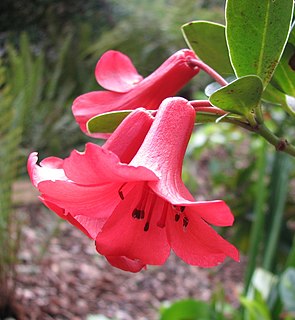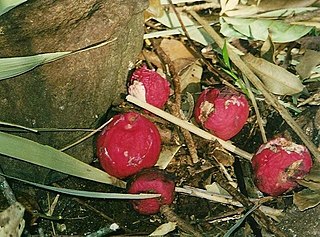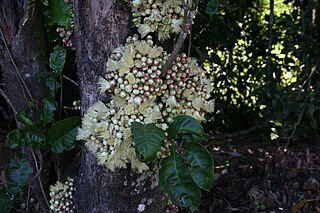
Syzygium is a genus of flowering plants that belongs to the myrtle family, Myrtaceae. The genus comprises about 1200 species, and has a native range that extends from Africa and Madagascar through southern Asia east through the Pacific. Its highest levels of diversity occur from Malaysia to northeastern Australia, where many species are very poorly known and many more have not been described taxonomically.

Backhousia is a genus of thirteen currently known species of flowering plants in the family Myrtaceae. All the currently known species are endemic to Australia in the rainforests and seasonally dry forests of Queensland, New South Wales and Western Australia.
Acmena was formerly the name of a genus of shrubs and trees in the myrtle family Myrtaceae. The genus was first formally described in 1828 by Augustin Pyramus de Candolle in his Prodromus Systematis Naturalis Regni Vegetabilis.

Prostanthera lasianthos, commonly known as the Victorian Christmas bush, is a large shrub or small tree of the mint family, Lamiaceae, which is native to Queensland, New South Wales, Victoria and Tasmania in Australia. It grows up to 10 m (35 ft) high but is usually much less and is found in wet sclerophyll forests, often beside creeks. Its flowers, which appear in profuse sprays, are about 2 cm long and white or pale lilac, with purple and orange blotches in the throat. They appear in late spring and summer, and specifically around Christmas time in Victoria. The fragrant, toothed leaves are 4 to 12 cm long and about 1.5 cm wide.

Lagunaria is a genus in the family Malvaceae. It is an Australian plant which is native to Lord Howe Island, Norfolk Island and parts of coastal Queensland. It has been introduced to many parts of the world. The genus was named for its resemblance to the earlier genus Laguna Cav., which was named in honour of Andrés Laguna, a Spanish botanist and a physician to Pope Julius III.

Rhododendron lochiae is a species of flowering plant, one of only two recognised species of the genus Rhododendron. It is found growing naturally in Australia, only in restricted mountain–top cloud forest habitats (endemic) within the tropical rainforests region of north eastern Queensland. The other species, Rhododendron viriosum, was only formally classified as a separate species in 2002. They are members of the heath family Ericaceae.

Litsea reticulata is a common Australian tree, growing from near Milton, New South Wales to the Bunya Mountains, Queensland. Common names include bollygum, bolly wood and brown beech. The habitat of the bollygum is rainforest of most types, except the dryer forms.

Syzygium ingens, commonly known as red apple, is a species of flowering plant that is endemic to eastern Australia. It is a medium-sized to tall rainforest tree with narrow elliptic to oblong leaves and panicles of white flowers on the ends of branchlets, followed by spherical red berries.

Syzygium hemilamprum, commonly known as the broad-leaved lilly pilly, blush satinash, cassowary gum, Eungella gum, and treated as Acmena hemilampra in New South Wales and Queensland, is a species of flowering plant in the family Myrtaceae and is native to New South Wales, Queensland and the Northern Territory. It is a rainforest tree with broadly lance-shaped to elliptic leaves, panicles of white flowers and more or less spherical white fruit.

Xanthostemon chrysanthus, commonly named Golden Penda, also popularly known as First Love, is a species of tree in the myrtle family Myrtaceae, endemic to north eastern Queensland.
Bleasdalea bleasdalei is a species of rainforest tree in the family Proteaceae from far north Queensland. First described as Grevillea bleasdalei by Ferdinand von Mueller, it was placed in its current genus in 1975.

Pseudoweinmannia lachnocarpa is a rainforest tree of eastern Australia. Common names include rose marara, mararie, scrub rosewood and red carabeen. The species name lachnocarpa is from the Greek, referring to the "woolly fruit". The genus name refers to the similarity of another genus, Weinmannia, after the German eighteenth century pharmacist J.W. Weinmann.

Litsea bindoniana, known as the big-leaved bollywood is a rainforest tree in the laurel family. A small to medium-sized bushy tree endemic to the rainforests of tropical Queensland, Australia. It features large leaves with attractive yellow venation, 25 cm (10 in) long by 10 cm (4 in) wide. They are dark green above, and paler and somewhat hairy below. The leaf stalks are hairy. The small greenish flowers are fragrant and occur from March to May. They are followed by fruits which mature from September to October, being a black drupe. Regeneration is from fresh seed, after removing the fleshy aril around the seed.

Allocasuarina inophloia, also known as woolly oak, or stringybark she-oak, is a shrub or small tree of the she-oak family Casuarinaceae endemic to inland New South Wales and Queensland. The hairy bark is an unusual feature.
Syzygium nervosum is a species of Syzygium tree native to tropical Asia, extending as far north as Guangdong and Guangxi in China and as far south as the Northern Territory of Australia. It was previously known as Cleistocalyx operculatus and also known as C. nervosum(DC.) Kosterm., and Eugenia operculataRoxb., 1832. It is a medium-sized tree of about 10 meters in height with pale brown bark and dull green leaves.

Syzygium cormiflorum, commonly known as the bumpy satinash, is a species of Syzygium tree endemic to Queensland in northeastern Australia.

Darlingia darlingiana is a rainforest tree of the family Proteaceae from Northern Queensland. It was described by Ferdinand von Mueller in 1865 as Helicia darlingiana.
Maytenus bilocularis, commonly known as orangebark, is a tree that is endemic to eastern Australia. It grows to 10 metres high and has leaves with toothed edges that are 3 to 9 cm long and 1.3 to 3 cm wide and elliptic, ovate or obovate in shape.

Toechima daemelianum, commonly known as cape tamarind, is an evergreen tree from north-east Queensland in Australia. It grows up to 13 metres high and a trunk which may be up to 20 cm wide.

Cranfillia fullagari, synonym Blechnum fullagarii, is a fern in the family Blechnaceae. The specific epithet honours James Fullagar, who collected plants on Lord Howe Island for the Royal Botanic Gardens, Melbourne.

















